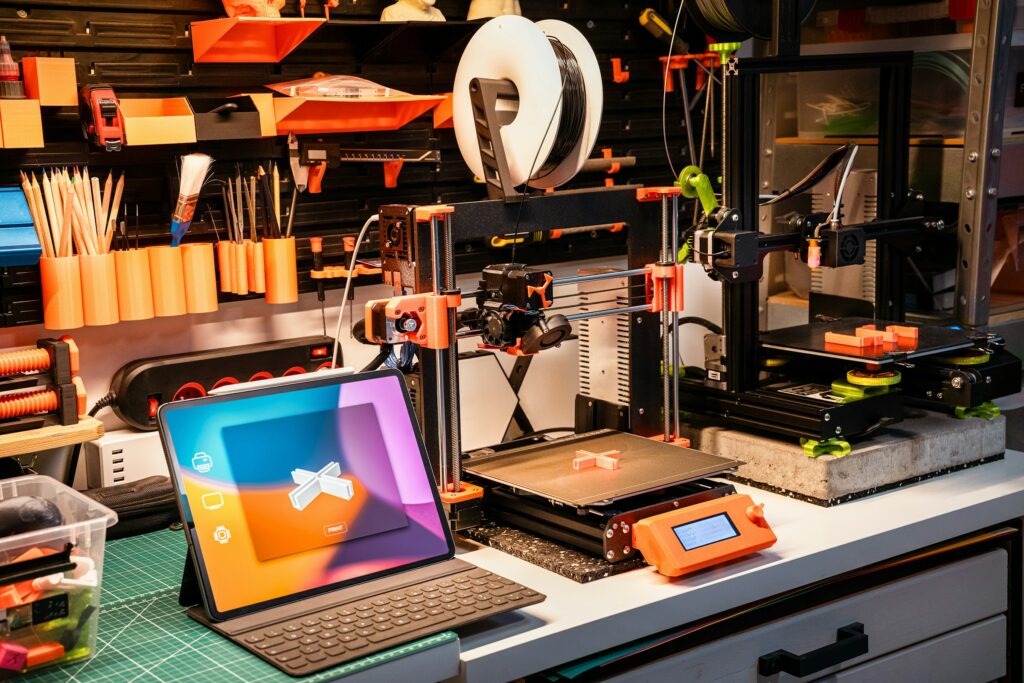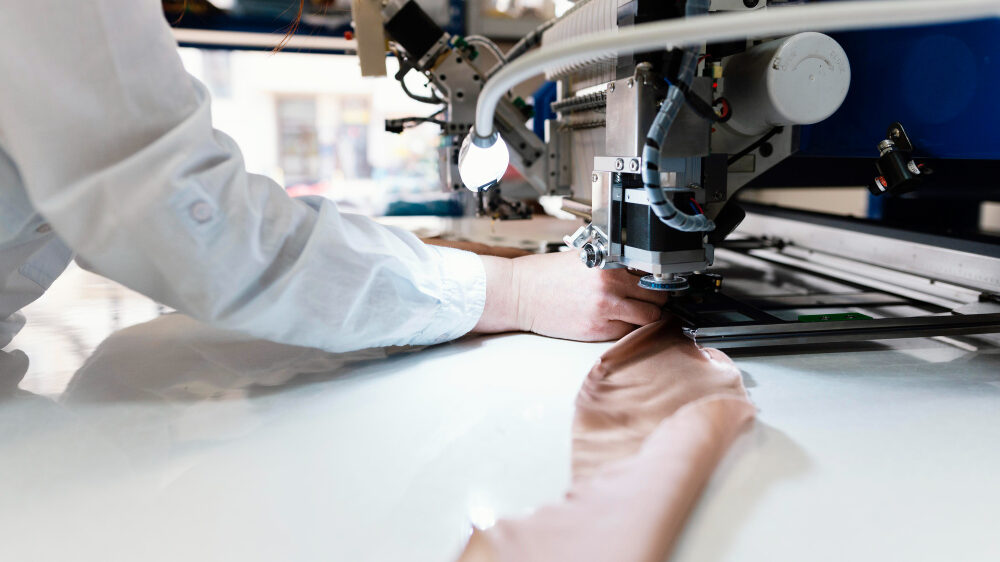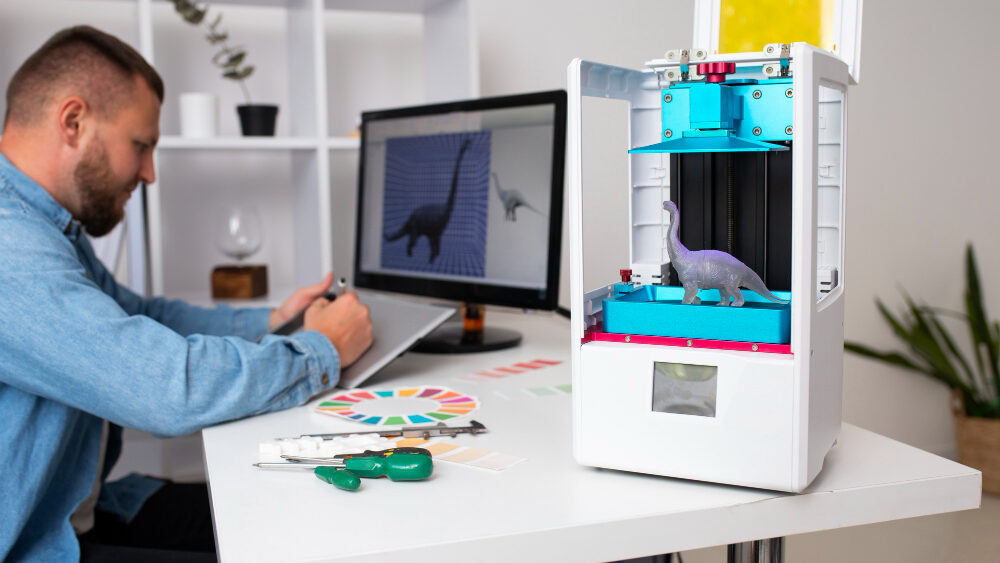Understanding the various technical terms associated with 3D printing is essential if you want to grasp all its intricacies. That’s why Imprimy offer you a comprehensive guide to the terms and definitions with our 3D printing glossary, designed to help you understand everything when diving into the world of 3D printing.

What are the main topics to fully understand 3D printing??
The main aspects of 3D printing are related to the operation of 3D printers, the different technologies they incorporate, the materials they use, and their various fields of application.
The functioning of 3D printing
3D printing, also known as additive manufacturing, is a process of creating a three-dimensional object by layering a predefined material based on a digital model.
This model, often designed using CAD software, is converted into G-code instructions specifically for 3D printers. Once the printing is complete, post-processing steps may be necessary to enhance the quality and final appearance of the object.
The technologies used to perform 3D printing
The most common 3D printing technologies include:
- FDM (Fused Deposition Modeling), which works by extruding melted thermoplastic filaments to create layer-by-layer overlays, shaping the object;
- SLA (Stereolithography), which uses a laser to cure photosensitive resins;
- SLS (Selective Laser Sintering), which employs a laser to sinter polymer or metal powder in successive layers;
- DLP (Digital Light Processing), similar to SLA but using a digital light source;
- Multi Jet Fusion (MJF), which utilizes fusion and finishing agents with a powder bed to produce detailed and robust objects.
Each of these technologies has its own advantages and limitations, making them suitable for specific applications, materials, and industrial needs.
The materials used in 3D printing
The materials used in 3D printing vary depending on the technology employed and the targeted applications.
Thermoplastics such as PLA (Polylactic Acid), biodegradable and easy to print, and ABS (Acrylonitrile Butadiene Styrene), which is resistant to impact and heat, are commonly used in FDM printing processes. PETG (Polyethylene Terephthalate Glycol) combines the benefits of both PLA and ABS, offering strength and ease of use. Photosensitive resins, used in SLA and DLP technologies, allow for detailed and smooth prints.
For more industrial applications, you might turn to SLS technologies. These work with polymer powders like nylon or metal powders to create parts that are both robust and functional. Other materials include composite elements reinforced with fibers, ceramics, and even biomedical materials. Each of these materials addresses specific needs based on their mechanical properties, chemical resistance, or biocompatibility.
The different application areas of 3D printing
3D printing allows applications in many fields, thereby revolutionizing sectors such as medicine, aerospace, automotive, and industrial manufacturing.
In medicine, 3D printing enables the creation of custom prosthetics, implants, and anatomical models for surgical planning. In aerospace and automotive, these technologies are used to produce lightweight, complex parts, thereby improving performance and reducing production costs.
Industrial manufacturers use these technologies for rapid prototyping, which helps reduce development cycles and facilitates design iterations until the final piece is created. 3D printing is also expanding into the fashion sector, allowing customization of clothing and accessories. The food industry is not left out, as 3D printing technologies are used to create innovative food structures.
Finally, architecture and construction also benefit from 3D printing by creating detailed models and complex building elements.
Discover our 3D printing glossary
Discover all the terms you need to know to fully understand 3D printing.
Terms starting with A :
- ABS: Acrylonitrile Butadiene Styrene (ABS) is a durable thermoplastic known for its toughness and impact resistance, often used in 3D printing for its mechanical properties and durability.
- Axes X, Y, Z: The X, Y, and Z axes represent the lateral, longitudinal, and vertical directions, respectively. These axes allow the movement of the print head or print bed to build three-dimensional objects layer by layer.”
Terms starting with B :
- Bridging: Bridging refers to an printer’s ability to create bridges or spans between two distant points without the need for support material. This requires good management of temperature and speed to ensure the strength of the printed structure.
- Build plate: The build plate, build surface, or construction surface refers to the surface on which your objects are printed. This surface is often heated to improve material adhesion and minimize warping. These surfaces can be made from various materials such as glass, PEI, or BuildTak and may be textured to optimize the results of your prints.
Terms starting with C :
- CAD (Computer-Aided Design): CAD refers to the software and technologies used to create models and technical drawings in 2D or 3D through geometric modeling. These technologies are primarily used in detailed design and computer-aided manufacturing.
- Calibration: Calibration refers to the precise adjustment process followed by 3D printers, such as leveling the bed, extrusion flow, or temperature, to ensure that prints are accurate and of high quality.
- Cooling time: Cooling time refers to the period required after each layer of printing to allow the material to harden and stabilize. Monitoring this time helps reduce deformation risks and improves the accuracy of the details in your print.
Terms starting with D :
- Deformation : Deformation (or warping) refers to the phenomenon where the edges or corners of printed objects lift or curve, often due to temperature variations of the print bed or internal material stresses during cooling.
- Direct Drive: The Direct Drive technology refers to a system where the extruder is mounted directly on the printer’s carriage, providing more precise control and better handling of flexible filaments, as opposed to the Bowden system, where the extruder is mounted away from the print head.
- DLP (Digital Light Processing): DLP (Digital Light Processing) is a 3D printing technology that uses a digital projector to cure layers of photosensitive resin at high resolution. This process allows for the creation of objects that are particularly detailed and have a smooth surface finish.
Terms starting with E :
- Extruder: The extruder is the mechanism that pushes the thermoplastic filament to the nozzle, where it is melted and forms successive layers that create a 3D printed object.
- Extrusion temperature: Extrusion tempreature refers to the temperature at which the thermoplastic filament is heated to melt and extrude through the nozzle. This allows the filament to be used for forming the layers of a printed object.
Terms starting with F :
- Filament: The filament is a material in the form of a continuous thread, often made of plastic such as PLA or ABS. It is used as raw material to create 3D printed objects.
- Firmware: The firmware refers to the embedded software in the 3D printer that controls all of its hardware operations, such as the movement of the axes, temperature management, and communication with the slicers and users of the machine.
- FDM: Fused Deposition Modeling (FDM) is a 3D printing technology that uses melted thermoplastic filaments extruded through a nozzle to build objects layer by layer.
- First Layer Adhesion: Good first layer adhesion is essential in 3D printing to ensure the stability of the printed objects, preventing warping and shifting during the printing process.
Terms starting with G :
- G-code: G-code is the programming language used to control the movements and actions of 3D printers. It instructs the machine on the paths to follow, the speed at which it should move, the temperature at which the filament should melt, and all other parameters required to create 3D objects.
Terms starting with H :
- Heated Bed: A heated bed is the platform on which the object is printed, and it can be heated to a certain temperature to improve adhesion. Heated beds provide a stronger first layer, reducing warping and allowing the use of temperature-sensitive materials.
- Heated bed temperature: Heated bed temperature refers to the controlled heat applied to the print platform to improve adhesion. It helps prevent warping by ensuring a stable and uniformly heated surface for the material you’re printing with. refers to the controlled heat applied to the print platform to improve adhesion. It helps prevent warping by ensuring a stable and uniformly heated surface for the material you’re printing with.
- Heated Chamber: A heated chamber refers to a print bed that can be heated to maintain a constant temperature, improving adhesion and stability of printed objects, especially when working with materials prone to shrinkage and reducing warping.
- Hotend: The hotend is the metal component through which the molten filament is extruded and deposited onto the print bed, forming successive layers to create the object being printed.
Terms starting with I :
- Infill: Infill refers to the internal fill density of a 3D printed object. The amount of material deposited between the outer walls, usually determined as a percentage, affects both the strength and the final weight of the object.
Terms starting with J :
Terms starting with K :
Terms starting with L:
- Lattice : A lattice is an internal support structure in the form of a grid used to reinforce printed objects, reducing weight and print time while maintaining significant structural stability.
Terms starting with M :
- Model: A 3D model refers to the three-dimensional digital representation of an object or shape, created through computer-aided design (CAD) for visualization, analysis, and fabrication using technologies such as 3D printing.
Terms starting with N :
- Nozzle : The nozzle is the metal part of a 3D printer through which molten filament is extruded onto the print bed to build up an object layer by layer..
Terms starting with O :
Terms starting with P :
- PETG: Polyethylene Terephthalate Glycol (PETG) is a thermoplastic material used in 3D printing for its strength, flexibility, and ease of printing. It combines the properties of PLA and ABS, making it suitable for a wide range of applications.
- PLA: Polylactic Acid (PLA) is a biodegradable bioplastic and an easy-to-print material in 3D. It is widely used due to its environmental compatibility, safety, and ease of use for various applications, especially recreational or decorative ones.
- Post-processing: Post-processing refers to all the steps taken after 3D printing to enhance the appearance, strength, or other properties of the printed object. This typically includes sanding, painting, polishing, or chemical treatments like electroplating.
- Printing speed: The printing speed refers to the rate at which the print head moves to deposit melted material and build each layer of a 3D printed object. This speed directly influences both the duration of the print and the final quality of the object.
Terms starting with Q :
Terms starting with R :
- Raft: A raft is a temporary support structure placed under the 3D printed object to improve its adhesion to the print bed. These additions are especially useful for printing parts with a small surface area or to reduce warping.
- Resin: Resin is a liquid material that polymerizes under UV light or another energy source. This material is primarily used in SLA and DLP technologies to create precise and detailed objects by solidifying layers one by one.
Terms starting with S :
- SLA: Stereolithography (SLA) is a 3D printing technology that uses a UV laser to selectively solidify photopolymerizable liquid resins layer by layer. It is one of the methods that enables the creation of objects with fine details and remarkable resolution.
- Slicer: A slicer is a software that converts a 3D model into specific instructions (see “G-code”). These instructions guide the 3D printer to build the object layer by layer, allowing users to adjust aspects such as print speed, temperature, and infill density.
- SLS: Selective Laser Sintering (SLS) is a 3D printing technology that uses a laser to heat and fuse layers of polymer or metal powders. This technology allows the creation of solid and complex objects without requiring additional support structures.
- STL: An STL (STereoLithography) file is a file format used in 3D printing to represent 3D models as triangular meshes. STL files are widely accepted by computer-aided design (CAD) software and slicers, making it easy to prepare 3D models for printing.
- Supports: Supports are temporary structures added under overhanging parts of 3D printed objects to ensure stability during printing. These additions facilitate the printing of complex details without causing the object to collapse.
Terms starting with T :
- Teflon (also known as Polytetrafluoroethylene or PTFE) is a heat-resistant, chemically resistant, and low-friction fluoropolymer. It is mainly used in 3D printing as a non-stick coating for filament guiding tubes and extruder surfaces.
- Thermistor: A thermistor is a temperature sensor used to precisely measure the temperature of the hot end, heated bed, or other critical components. The readings allow the printer to automatically adjust its settings to ensure optimal printing conditions.
- Three-dimensional: The term “three-dimensional” refers to the ability to create objects with three dimensions (width, height, and depth) by adding successive layers of material to form a tangible volumetric structure.
Terms starting with U :
Terms starting with V :
- Viscosity: Viscosity refers to the measure of a material’s resistance to flow. This measurement influences how easily the material can be extruded through the nozzle, as well as the quality of the printed object.
Terms starting with W :
- Warping : Warping refers to the deformation or bending of a 3D printed object, typically occurring when the material cools unevenly, causing the edges or corners to lift or curl away from the print bed.
Terms starting with X :
Terms starting with Y :
Terms starting with Z :
Conclusion: Why is it important to know the terms associated with 3D printing?
Knowing the terms associated with 3D printing is essential to understanding the nuances of this complex technology and optimizing your printing projects. Whether you’re a beginner or an experienced user, mastering the vocabulary helps navigate various aspects of the process, from 3D model design to the final result. It allows you to solve potential issues, adjust printing parameters accurately, and make the most of the materials and technologies available. Furthermore, understanding these terms facilitates communication with other enthusiasts, professionals, or support forums, while improving your skills and the quality of your prints.
Picture by Jakub Żerdzicki from Unsplash
The articles published on Imprimy.com are for informational purposes only. They are intended to provide general advice and information related to 3D printing. Imprimy.com cannot be held responsible for the results obtained or the consequences arising from the application of the shared information. We recommend always checking the specific instructions for your hardware and materials before use.
Check our other content about 3D printing glossary :
Silicone 3D printing: a revolution in custom manufacturing
Are you curious about silicone 3D printing and want to learn more about it? At…
3D printing textile
Are you wondering about 3D textile printing and its capabilities? At Imprimy.com, we are here…
SLA 3D Printing
Are you wondering about SLA 3D printing and its specific features? At Imprimy.com, we’re here…



